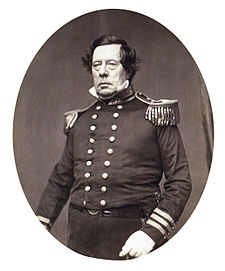I mean, I guess you could say that there is a definite typhoon season, and I'm sure that there are any number of typhoons who terrorize Okinawa, never to give the four main islands of Japan a second glance... and Hokkaido, based on my personal experience, is generally lacking in any sort of major typhoon experience, on the whole...
"Typhoon, you say? What on earth is that? By the by, splendid weather we're having, isn't it old boy? Pip pip. Now, what say you open up your country so I'm not forced to blow you to pieces, gentlemen?"
... ok, I am actually quite certain that Commodore Perry did not, in fact, speak with an posh, stuffy English accent*, seeing as he was, in fact, American, but hey. A girl can dream, can't she?
Besides, tell me that this man does not strike you with anything other than an air of general stuffy aloofness:
 |
| "Harumph, I say to you sir! Harumph!" - Possibly Commodore Perry |
Anyway, for those of you who didn't take advantage of the useful link I posted above, Wikipedia tells us the following:
The North American monsoon, variously known as the Southwest United States monsoon, the Mexican monsoon, or the Arizona monsoon, is experienced as a pronounced increase in rainfall from an extremely dry June to a rainy July over large areas of the southwestern United States and northwestern Mexico. These summer rains typically last until mid-September when a drier regime is reestablished over the region. Geographically, the NA monsoon precipitation region is centered over the Sierra Madre Occidental in the Mexican states of Sinaloa, Durango, Sonora and Chihuahua.Whereas a typhoon is
... a mature tropical cyclone that develops in the northwestern part of the Pacific Ocean between 180° and 100°E. This region is referred to as the northwest Pacific basin.
... and it also says there is no specific season. Ah ha. Ok, so, um. Maybe we're different.
But hey! Although I was originally inspired by the rather nice monsoon storm we had this evening, what struck me later was the strange phonological similarity between the two words. Oh come now, monsoon, typhoon?
... ok. You're right, I know. This is completely groundless based on the fact that "typhoon" is actually taifuu (台風), and how we managed to tack a random "n" onto the end is absolutely boggling, really... but then these things do go both ways, after all. Look at cabbage (キャベツ, kyabetsu), for crying out loud.
But I digress again.
Etymologically speaking, "monsoon" probably developed from either Portuguese, after (maybe) developing from an Arabic word meaning "season." In comparison, taifuu combines the character for "wind" (風, kaze or fuu) and... uh... the... Um. The character for a pedestal? The... counter... for... machines and vehicles?
... Ok. I'm sure that there's a reason, not to mention some fascinating etymology behind this one, but... well... It's late and suddenly I've stopped caring all that much.
REGARDLESS, both Japan and America have some potentially very damaging summer(-ish, in the case of Japan) storms to be dealt with. Ok, I guess Japan may have the shorter end of the stick, what with massively destructive winds and all... but then we have microbursts, and that whole flash-flood problem endemic to a desert environment... and I mean, everyone has to deal with power outages... But Japan does have ocean issues to deal with, and....
...
SCREW IT LET'S JUST LOOK AT PICTURES.
Oooo.
Aaah.
Predictions!
Doppler! (Of what's going on right now, no less!)
... WAIT.
I figured out something that only we have.
Haboobs!
We even got on national news with one this year.
... definitely fun trying to explain that one to friends who didn't grow up here, though.
"Do you ever get those big walls of dust in the summer here in California?"
"You mean dust storms?"
"No... Well, yea, dust storms, but..."
"...?"
"You know, walls of dust! They just swallow the city, kind of thing?"
"... what are you talking about?"
"... you know..."
"I do?"
"... haboobs..."
"..."
It's always fun trying to convince them that you're not making the word up... especially when you accidentally used the diminutive form "haboobie" without thinking. That'll go over well.
And with that final digression, this is Edo, signing off having learned her lesson once and for all about letting the weather inspire blog posts.
*Although that might explain how taifuu got butchered into typhoon. I admit that this is probably unfair, and that I've been somewhat jaded by watching contestants on a certain British quiz show repeatedly butcher Japanese while doing very well with the likes of, say, German. Oh, well.






1 comment:
Hey ^^ Interesting post !
Typhoo are pretty scarry ^^;
Actually I would like to know if you or readers of this blog are interested in writing about the way you have personnally experienced the Northeastern Japan Earthquake (if you haven't but you know people who have experienced the earthquake in Japan, it'd be great if you coud let him/her know about this).
Tokyo Room Finder Short Essay Contest is an online project to gather heart-warming experiences following the earthquake in Japan. We strongly believe that sharing those experiences will give people hope and revitalize Japan.
We also offer 2 tickets for Tokyo Disney Resort to each of the winners.
For more details : http://tokyoroomfinder.blogspot.com/
Post a Comment